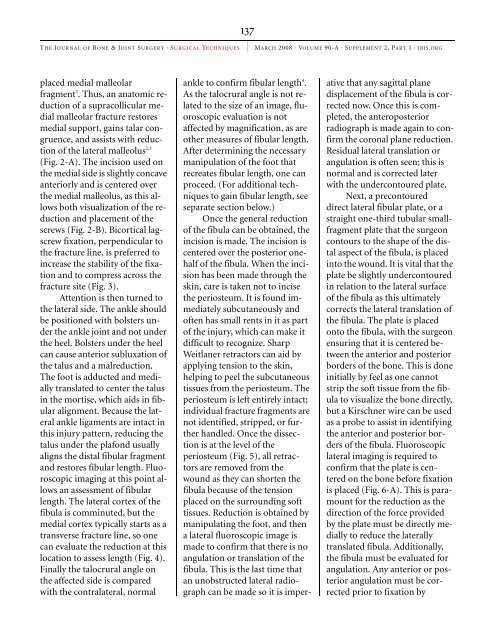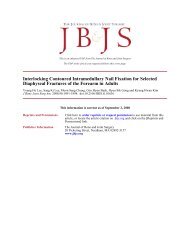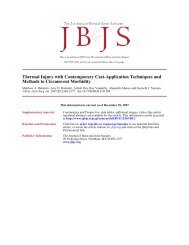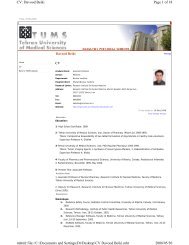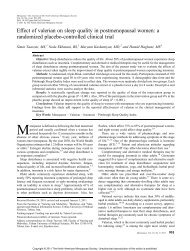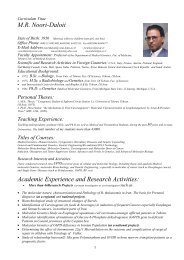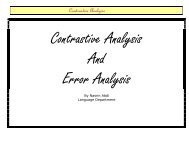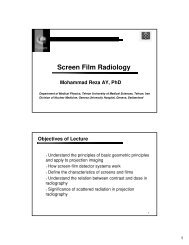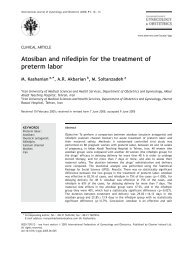Extraperiosteal Plating of Pronation-Abduction Ankle Fractures
Extraperiosteal Plating of Pronation-Abduction Ankle Fractures
Extraperiosteal Plating of Pronation-Abduction Ankle Fractures
Create successful ePaper yourself
Turn your PDF publications into a flip-book with our unique Google optimized e-Paper software.
137<br />
T HE JOURNAL OF BONE & JOINT SURGERY · SURGICAL TECHNIQUES MARCH 2008 · VOLUME 90-A · SUPPLEMENT 2, PART 1 · JBJS.ORG<br />
placed medial malleolar<br />
fragment 2 . Thus, an anatomic reduction<br />
<strong>of</strong> a supracollicular medial<br />
malleolar fracture restores<br />
medial support, gains talar congruence,<br />
and assists with reduction<br />
<strong>of</strong> the lateral malleolus 2,3<br />
(Fig. 2-A). The incision used on<br />
the medial side is slightly concave<br />
anteriorly and is centered over<br />
the medial malleolus, as this allows<br />
both visualization <strong>of</strong> the reduction<br />
and placement <strong>of</strong> the<br />
screws (Fig. 2-B). Bicortical lagscrew<br />
fixation, perpendicular to<br />
the fracture line, is preferred to<br />
increase the stability <strong>of</strong> the fixation<br />
and to compress across the<br />
fracture site (Fig. 3).<br />
Attention is then turned to<br />
the lateral side. The ankle should<br />
be positioned with bolsters under<br />
the ankle joint and not under<br />
the heel. Bolsters under the heel<br />
can cause anterior subluxation <strong>of</strong><br />
the talus and a malreduction.<br />
The foot is adducted and medially<br />
translated to center the talus<br />
in the mortise, which aids in fibular<br />
alignment. Because the lateral<br />
ankle ligaments are intact in<br />
this injury pattern, reducing the<br />
talus under the plafond usually<br />
aligns the distal fibular fragment<br />
and restores fibular length. Fluoroscopic<br />
imaging at this point allows<br />
an assessment <strong>of</strong> fibular<br />
length. The lateral cortex <strong>of</strong> the<br />
fibula is comminuted, but the<br />
medial cortex typically starts as a<br />
transverse fracture line, so one<br />
can evaluate the reduction at this<br />
location to assess length (Fig. 4).<br />
Finally the talocrural angle on<br />
the affected side is compared<br />
with the contralateral, normal<br />
ankle to confirm fibular length 4 .<br />
As the talocrural angle is not related<br />
to the size <strong>of</strong> an image, fluoroscopic<br />
evaluation is not<br />
affected by magnification, as are<br />
other measures <strong>of</strong> fibular length.<br />
After determining the necessary<br />
manipulation <strong>of</strong> the foot that<br />
recreates fibular length, one can<br />
proceed. (For additional techniques<br />
to gain fibular length, see<br />
separate section below.)<br />
Once the general reduction<br />
<strong>of</strong> the fibula can be obtained, the<br />
incision is made. The incision is<br />
centered over the posterior onehalf<br />
<strong>of</strong> the fibula. When the incision<br />
has been made through the<br />
skin, care is taken not to incise<br />
the periosteum. It is found immediately<br />
subcutaneously and<br />
<strong>of</strong>ten has small rents in it as part<br />
<strong>of</strong> the injury, which can make it<br />
difficult to recognize. Sharp<br />
Weitlaner retractors can aid by<br />
applying tension to the skin,<br />
helping to peel the subcutaneous<br />
tissues from the periosteum. The<br />
periosteum is left entirely intact;<br />
individual fracture fragments are<br />
not identified, stripped, or further<br />
handled. Once the dissection<br />
is at the level <strong>of</strong> the<br />
periosteum (Fig. 5), all retractors<br />
are removed from the<br />
wound as they can shorten the<br />
fibula because <strong>of</strong> the tension<br />
placed on the surrounding s<strong>of</strong>t<br />
tissues. Reduction is obtained by<br />
manipulating the foot, and then<br />
a lateral fluoroscopic image is<br />
made to confirm that there is no<br />
angulation or translation <strong>of</strong> the<br />
fibula. This is the last time that<br />
an unobstructed lateral radiograph<br />
can be made so it is imper-<br />
ative that any sagittal plane<br />
displacement <strong>of</strong> the fibula is corrected<br />
now. Once this is completed,<br />
the anteroposterior<br />
radiograph is made again to confirm<br />
the coronal plane reduction.<br />
Residual lateral translation or<br />
angulation is <strong>of</strong>ten seen; this is<br />
normal and is corrected later<br />
with the undercontoured plate.<br />
Next, a precontoured<br />
direct lateral fibular plate, or a<br />
straight one-third tubular smallfragment<br />
plate that the surgeon<br />
contours to the shape <strong>of</strong> the distal<br />
aspect <strong>of</strong> the fibula, is placed<br />
into the wound. It is vital that the<br />
plate be slightly undercontoured<br />
in relation to the lateral surface<br />
<strong>of</strong> the fibula as this ultimately<br />
corrects the lateral translation <strong>of</strong><br />
the fibula. The plate is placed<br />
onto the fibula, with the surgeon<br />
ensuring that it is centered between<br />
the anterior and posterior<br />
borders <strong>of</strong> the bone. This is done<br />
initially by feel as one cannot<br />
strip the s<strong>of</strong>t tissue from the fibula<br />
to visualize the bone directly,<br />
but a Kirschner wire can be used<br />
as a probe to assist in identifying<br />
the anterior and posterior borders<br />
<strong>of</strong> the fibula. Fluoroscopic<br />
lateral imaging is required to<br />
confirm that the plate is centered<br />
on the bone before fixation<br />
is placed (Fig. 6-A). This is paramount<br />
for the reduction as the<br />
direction <strong>of</strong> the force provided<br />
by the plate must be directly medially<br />
to reduce the laterally<br />
translated fibula. Additionally,<br />
the fibula must be evaluated for<br />
angulation. Any anterior or posterior<br />
angulation must be corrected<br />
prior to fixation by


